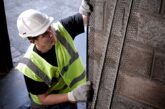
I have always enjoyed rendering and plastering. It has been a journey of gradual improvement, and every time I finish a job I look and think about all the ways I might have done it better.
Having said that, I have also looked at a good many other jobs done by full-time professionals and thought the same thing – they may look OK most of the day but when the sun shines across them with that harsh raking light you can see more humps and bumps than the surface of the moon.
Some of that is unavoidable, but a lot is a result of relying too much upon the urethane float and not enough time spent ruling off the high spots and filling in the lows.
![]() Fortunately for this Weber monocouche job I had a couple of secret weapons from Refina – a large notched feather edge and, prize of prizes, an aluminium I Beam Refina, which improves the flatness far better than anything else I have used.
Fortunately for this Weber monocouche job I had a couple of secret weapons from Refina – a large notched feather edge and, prize of prizes, an aluminium I Beam Refina, which improves the flatness far better than anything else I have used.
The serrated feather edge levels the surface knocking back the high spots and exposing hollows without bringing any fat up. It also takes out air pockets, so you are almost ready for a rub over with the scratcher.
In our job the front porch was built from aircrete, so we coated the surface in Weberend Aide, which is a polymer-based bonding agent.
I then pressed fibreglass mesh into it while still wet and before it went off pricked it up to provide a key. I found a urethane float placed on and rapidly pulled off created just enough suction to prick it up perfectly.
The only drawback with using a different colour base coat is that you have to make sure the top coat is thick enough to allow you to scrape the surface without exposing the underlying colour. When you are applying a single coat to ![]() brickwork without the Weberend aide the risk of exposing the brick is less.
brickwork without the Weberend aide the risk of exposing the brick is less.
Although this is called monocouche I find it is better to go over it in two coats in rapid succession as you would with plaster.
The first coat will pull in slightly and you will probably see the bricks telegraph through. If you apply the second coat before the first has gone off there is no need to key it and with a little ruling across you will achieve a nice surface for scraping.
Why scrape? The idea of the scraping is to break the surface tension and prevent micro-crazing, which happens to any cement-based products.
On sand and cement render a coat of paint will cover the micro-grazing for good, but on through-coloured ![]() monocouche you are not painting, so the scrape finish is necessary. The downside of the scraped finish is that it can harbour dirt and algae.
monocouche you are not painting, so the scrape finish is necessary. The downside of the scraped finish is that it can harbour dirt and algae.
To combat this Weber has now introduced an algae-resistant ingredient, but you still need to take care of the detailing.
It is a good idea to prevent run-off from sills and parapets, which can cause ugly black streaks, especially in polluted areas. In fact, any horizontal surface needs to drip clear of the wall.
All these tricks of the trade can be picked up on a one day course at the Weber Training Academy.
I went there to pick up the basics and this was my first job. It won’t be my last because the people up the road have asked me for a price.
For more information click here.







